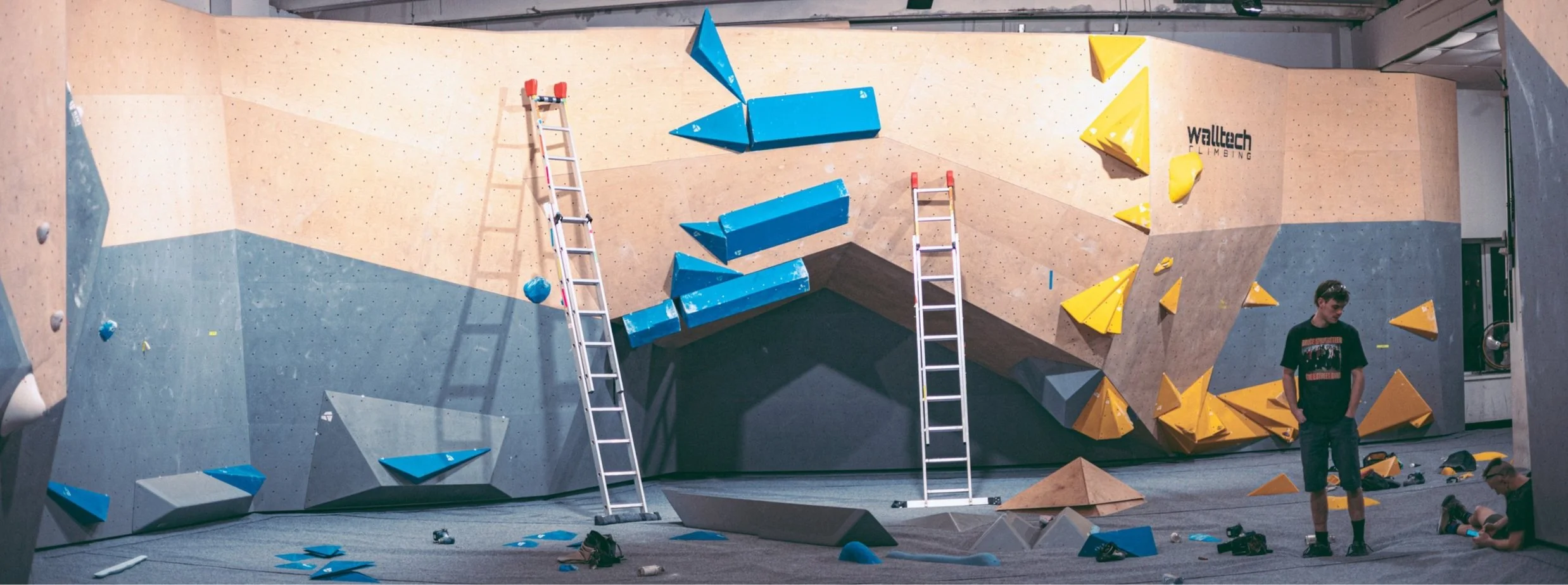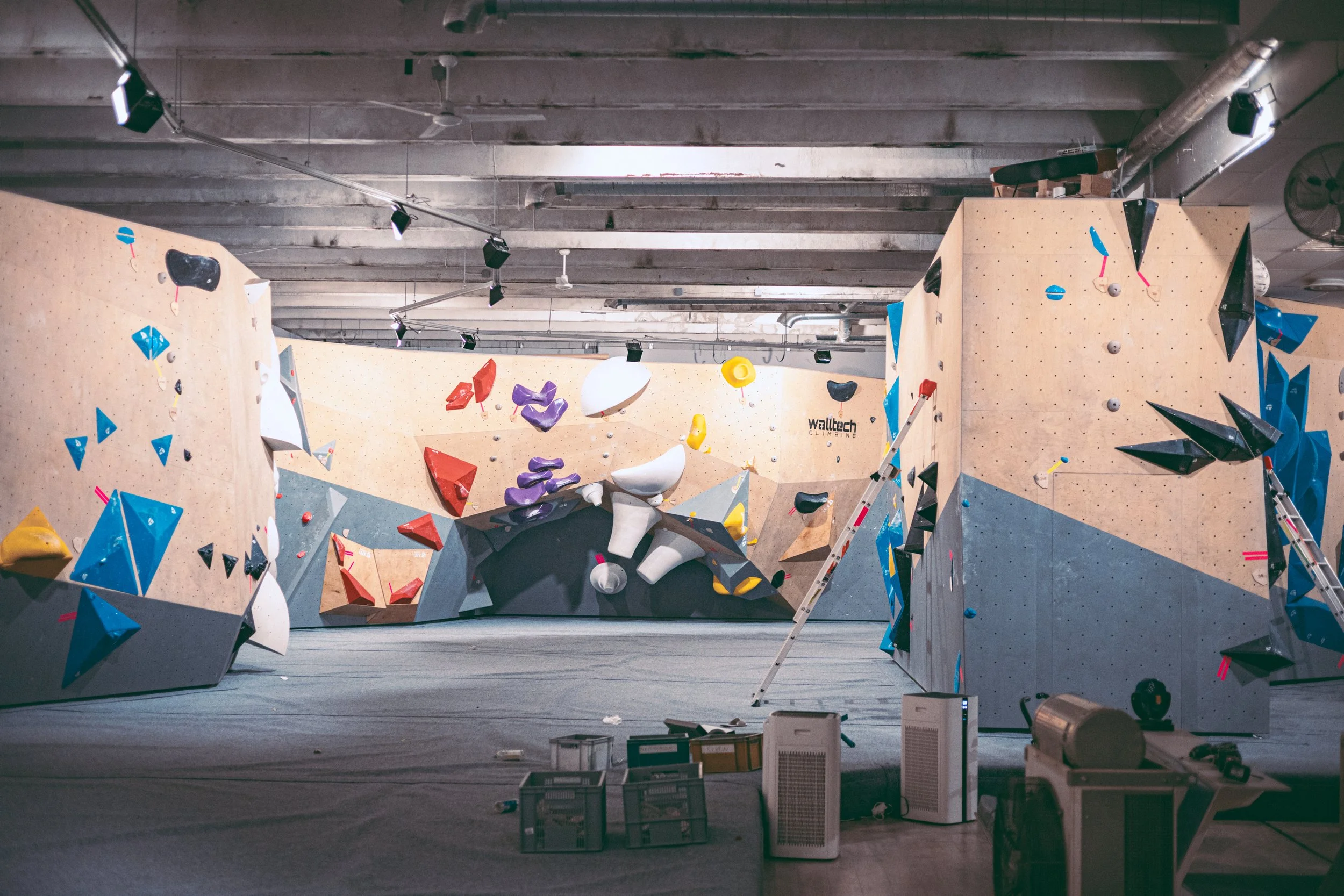Tallinn bouldering festival
Good days! The Asetus crew, in full force, has returned to our home base in Oulu. After three packed weeks of touring Europe, we wrapped it all up with an incredible competition weekend at Kivi Climbing in Tallinn, Estonia.
So much happened during these weeks that trying to capture it all in one blog post would be impossible. Let’s save the Central European stories for another time and dive straight into Tallinn: how did it go, and how did we get there?
The Journey to Tallinn
True to Asetus form, we opted for the cheapest (and scummiest) way to Tallinn: a 6:00 AM flight out of Bergamo. This meant yet another lovely night sleeping at the airport. On Wednesday, December 4, 2024, we arrived in Tallinn bright and early, with an entire day ahead of us at Kivi.
Time stood still as the empty walls stared at us during the day. We could sense the calm before the storm.
During the day, we met the rest of the setting team: an impressive international lineup featuring Atsushi, Ayari, Shingo, and Riku from Japan; Jakub from Poland; Dan from the U.S.; and Jaakko and me from Oulu. Quite the team, wouldn’t you say?
We spent the evening stripping the last remaining walls, clearing the stage for a fresh start the next morning.
Day 1: Finals Preparation
The alarm rang at 7:00 AM. I wasn’t feeling my best—tired, a slight fever, and a clogged nose—but Jaakko, being the sunshine he is, gave me the boost I needed to get moving. The day started with coffee, a slow breakfast, and some brainstorming with the team.
We had a goal: to create finals-worthy problems for a stacked field of competitors from across the Nordic and Baltic countries. We as Finns knew the athletes’ skill levels pretty well, so our mission was to guide the difficulty in the right direction.
From the start, the team dove headfirst into the finals routes. Holds went up, came down, and went back up again. As the day went on, the problems began to take shape, and by evening, we were confident we had crafted something special.
There were some interesting choice of holds used as well as moves presented. Definitely the style you would not typically see in this level of competition. Good example of that would be a mens final route which Ayari put up. It included only the tiniest few finger jibs, nothing else. We were left flabbergasted by how easy the Japanese made it look. You should have seen us mortals pulling on it…
By almost midnight, we wrapped up for the day. Jaakko created a phenomenal overhanging problem for the women, starting with a powerful body intensive sequence and finishing with a double-clutch that was a true crowd-pleaser. I went the opposite direction, designing a slow, delicate slab with cross-steps, smears, laybacks, and every bit of slabby trickery you can imagine.
We also worked on the men’s final problem, adding the signature Asetus touch to its already dramatic triple-jump start (designed by the Japanese). We created a “Transformer-style” finnish (:D), packed with jams, toe hooks, underclings, and more—a playground for athletes to showcase their unique styles.
Exhausted but satisfied, we finally called it a night.
Day 2: Qualification Routes
The next morning, the grind resumed. Coffee, breakfast, and back to work.
With over 200 competitors ranging from kids to professionals, the qualification routes needed to be as high-quality as the finals problems. We wanted every climber, regardless of skill, to have a memorable experience.
By the end of a grueling 20-hour day, we had created 35 qualification problems. Standing in the gym at 4:30 AM, staring at the boulders, doubts crept in. Were the problems too hard? Would the competitors enjoy them? With no time left to tweak, all we could do was wait and see.






Competition Day
The competition day arrived, and the field was divided into two qualification groups. As the first group started climbing, relief washed over us. The problems weren’t too hard; in fact, they were exactly as we’d hoped.
The climbers’ faces said it all—thrilled, challenged, and inspired. The qualifications achieved the perfect balance of separation, setting the stage for the finals.
Then came the last act: the finals.
With smoke machines, lights, DJs, live streams, cameras, and an electric crowd, the atmosphere was unforgettable. The athletes left it all on the wall, and the audience matched their intensity, erupting into cheers at every climactic moment.
Every problem offered something unique. On the men’s side, the battle came down to Tuukka Simonen (the beast from the north) and Anthony Gullsten (National hero from Finland). For the women, it was a clash between Finnish youth and Latvian powerhouses. In the end, Elza Baraka and Tuukka Simonen emerged victorious. Congratulations to them both!
Lessons Learned
- Eat, sleep, and drink coffee.
- Never underestimate the competitors.
- Well begun is half done.
- Always pay for travel insurance.
On a serious note, working with the Japanese setters challenged our perspective. Their commitment to tweaking routes to perfection—taking climbers far out of their comfort zones—felt almost masochistic at times.
As Westerners, we’re used to prioritizing customer satisfaction, so their methods initially felt counterintuitive. But after some sleep and reflection, we saw the value in their approach. A week later, we consciously incorporated some of their philosophy into a youth comp we set back home.
The result? A huge success. We were proud to challenge our local kids with something fresh and exciting, just as Jakub Stec summed up so perfectly in Tallinn:
"This is a climbing wall, not a ‘getting-up-every-route’ wall.”









